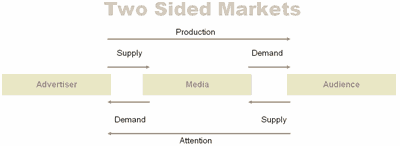It starts with an analysis of Media 1.0 economics and how supply meets demand. And then he shows where this model breaks down and finally how to take advantage of the new market.

There's a lot in here, much of which I can't get my head around yet, but one piece I like is the supposition that production costs don't efficiently capture attention at certain levels...at big media levels. In other words, expensive high quality content does not pay off. It's more efficient to spend money on ways to capture attention directly than it is to use high production value content as the bait.
"Blockbuster strategies emerge due to the natural economics of mass media: production is costlier than attention, so the dominant strategy is to invest in attention (marketing cost wars), and economize on production (quality erosion). The result is a smaller and smaller number of concentrated players, who are forced to invest more and more heavily in marketing as attention becomes scarcer."
This isn't true on smaller scales where media microchunks are both produced and disseminated cheaply. He explains that the fixed economies of mass media get hijacked by consumers who are able and willing to consume lots of content through convenient channels at low cost. The consequence is that production values stay low and quality gets fragmented and harder to find.
"Value shift: in a Media 2.0 world, producers realize production economies of scale and scope in production, and marketing diseconomies of scale and scope. Attention becomes more expensive than production, because technology vaporizes production (distribution, and retail) costs, exploding media supply (relative to a mass media world, where media supply is fixed), which creates intense rivalry for attention."
Mass media really feels the heat when micro media takes away the ability to franchise content. Soundtrack sales, video rental, syndication and other tie-ins enabled high production cost economics to scale. Micro media erodes those revenue streams and kills production-driven models.
But there's still hope.
He defines the effect of Media 2.0 on Media 1.0 as "hyperdeflation". Effective margins can't be found in average content (a boring article, a crappy film, a stupid song). But by leveraging the strengths of the new systems, margins can come back.
He goes on about Snowball Economics and defining how the 3 key types of players (Smart Aggregators, Microplatforms and Reconstructors) are going to serve the market most efficiently. But I loved this abstract description of the interplay between Media 2.0 and its consumers...
- DJ plays a selection of tracks
- Audience reveals preferences, expectations, and satisfaction with their feet: private info is made public
- Consumption externality: your dancing reduces my search and transaction costs
- Tracks which maximize aggregate utility are efficiently revealed, and value creation is maximized...
- ...across multiple niches/different genres of club music
- Music listeners are a connected network ... DJs realized it, the music industry didn’t...
- ...Now, dance music is the fastest growing segment of the music industry and the segment which most regularly produces snowballs

This presentation is a must read for people in Media 1.0, but it also puts some really powerful perspective on what those in Media 2.0 are doing whether they know it or not.
Trackbacks:
TrackBack URL:
http://www.mattmcalister.com/blog/_trackback/1743130
